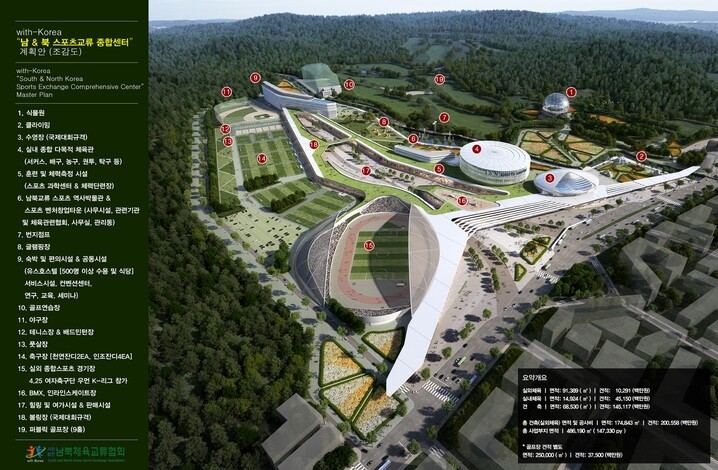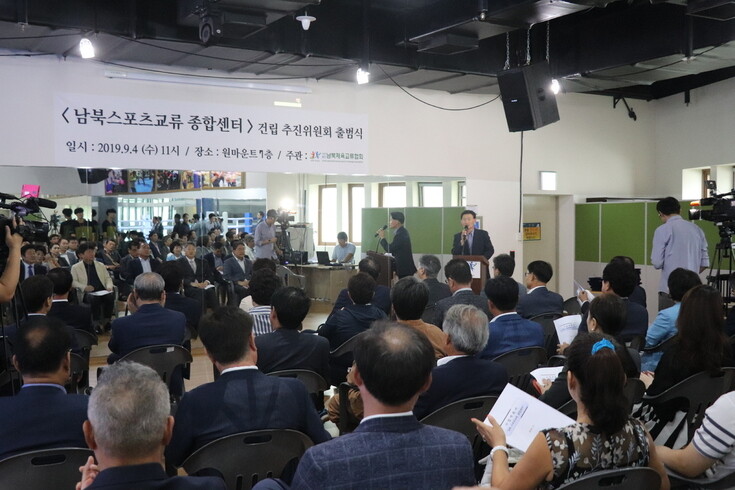hankyoreh
Links to other country sites 다른 나라 사이트 링크
Two Koreas pursue construction of inter-Korean sports exchange centers

South and North Korea are simultaneously pursuing the construction of inter-Korean sports exchange centers as privately operated facilities for use as bases for inter-Korean sports exchange and cooperation.
The South and North Korea Sports Exchange Association (SNKS) announced on Sept. 4 that construction of inter-Korean sports exchange centers for joint competitions and training by South and North Korean athletes and the training of future athletes was being simultaneously pursued by South and North Korea. The group has held 22 regular inter-Korean youth soccer exchange matches to date, including reciprocal visits over land by South and North Korean squads last year.
SNKS held a launch ceremony for the inter-Korean sports exchange center implementation committee at One Mount in Goyang, Gyeonggi Province, that morning and shared an aerial diagram of the South Korean center, project plan, and project fund procurement plan. The inter-Korean sports exchange center is to include an indoor multipurpose arena, outdoor stadium, sports venture business town, sports history museum, accommodations and amenities, and a nine-hole golf course. The site covers an area of 486,190 square meters, with anticipated project costs of 240 billion won (US$200.22 million). A full-scale effort to have a women’s soccer team from North Korea’s April 25 Sports Club participate in the South Korean women’s professional soccer league is to be pursued as a first project following the center’s completion.
The association plans to acquire a site for the project within the year through bidding with local governments in the Greater Seoul area. It also plans to seek partial support for project funds from the Inter-Korean Cooperation Fund and National Sports Promotion Fund through discussions with the Ministry of Unification (MOU) and Ministry of Culture, Sports and Tourism (MCST).
As a basis for soliciting support from government funds, the association cited regulations on the funds’ usage according to the Inter-Korean Cooperation Fund Act and National Sports Promotion Act. Article 4 of the management regulations for the Inter-Korean Cooperation Fund state that it is to provide “subsidization of all or some of the funds needed for cooperation projects in the fields of culture, art and science, and sports.”
The association also cited the government’s previous use of the funds to subsidize costs for the Korea Football Association’s construction of the Paju National Football Center in Gyeonggi Province, which was completed in 2001. Of the 13 billion won (US$10.84 million) in total construction costs, the KFA procured 3.1 billion (US$2.59 million), with the remainder subsidized by MCST, the Korea Sports Promotion Foundation, and the Olympics Organizing Committee.

SNKS also plans on building Pyongyang Sports Center
In addition to the sports exchange center in South Korea, the SNKS also plans to build and co-manage the “Pyongyang Sports Center” with North Korea. The center, which is to include a 27-hole golf course, is to be built on a 350,000 square meter site in Pyongyang, which has been provided free of change for a 50-year period by the North.
The association has supported training by North Korean athletes with the operation of the Hongta Sports Center in Kunming, China, since 2004, including events such as inter-Korean soccer, marathon, archery, table tennis, and shooting. In terms of person-days, over 5,000 inter-Korean athletes have participated in exchanges through the center over the past 15 years. North Korea has enjoyed strong performance thanks to the Hongta Sports Center’s systematic training, including successive victories at the U-20 Women’s World Cup in 2006 and U-17 Women’s World Cup in 2008. The sports center site was provided free of charge to the association by North Korea in recognition for its contributions to sports development.
“A framework for reciprocal visits over land was established through the inter-Korean youth soccer exchange match,” explained Kim Kyung-sung, the association’s chairman.
“Once the sports center is built in Pyongyang, South Korean athletes will be able to use it, but because there isn’t a training facility prepared in the South for North Korean athletes, we ended up pursuing the simultaneous construction of sports centers in South and North Korea,” he added.
Kim predicted that the construction of privately operated sports exchange centers would “contribute to balanced development and sports integration between South and North Korean sports by allowing sports exchange to be promoted regardless of the ebbs and flows of inter-Korean relations.”
“Since the North was first to provide a sports center site measuring 100,000 pyeong [330578.51 square meters], now it’s our turn to answer in kind,” he said.

By Park Kyung-man, staff reporter
Please direct comments or questions to [english@hani.co.kr]

Editorial・opinion
![[Column] Season 2 of special prosecutor probe may be coming to Korea soon [Column] Season 2 of special prosecutor probe may be coming to Korea soon](https://flexible.img.hani.co.kr/flexible/normal/500/300/imgdb/original/2024/0426/3317141030699447.jpg) [Column] Season 2 of special prosecutor probe may be coming to Korea soon
[Column] Season 2 of special prosecutor probe may be coming to Korea soon![[Column] Park Geun-hye déjà vu in Yoon Suk-yeol [Column] Park Geun-hye déjà vu in Yoon Suk-yeol](https://flexible.img.hani.co.kr/flexible/normal/500/300/imgdb/original/2024/0424/651713945113788.jpg) [Column] Park Geun-hye déjà vu in Yoon Suk-yeol
[Column] Park Geun-hye déjà vu in Yoon Suk-yeol- [Editorial] New weight of N. Korea’s nuclear threats makes dialogue all the more urgent
- [Guest essay] The real reason Korea’s new right wants to dub Rhee a founding father
- [Column] ‘Choson’: Is it time we start referring to N. Korea in its own terms?
- [Editorial] Japan’s rewriting of history with Korea has gone too far
- [Column] The president’s questionable capacity for dialogue
- [Column] Are chaebol firms just pizza pies for families to divvy up as they please?
- [Column] Has Korea, too, crossed the Rubicon on China?
- [Correspondent’s column] In Japan’s alliance with US, echoes of its past alliances with UK
Most viewed articles
- 1[Column] Season 2 of special prosecutor probe may be coming to Korea soon
- 2‘We must say no’: Seoul defense chief on Korean, USFK involvement in hypothetical Taiwan crisis
- 3Division commander ordered troops to enter raging flood waters before Marine died, survivor says
- 4Is N. Korea threatening to test nukes in response to possible new US-led sanctions body?
- 5Is Japan about to snatch control of Line messenger from Korea’s Naver?
- 6No good, very bad game for Korea puts it out of Olympics for first time since 1988
- 7[Editorial] Korea’s surprise Q1 growth requires objective assessment, not blind fanfare
- 8Korea’s 1.3% growth in Q1 signals ‘textbook’ return to growth, says government
- 9N. Korean delegation’s trip to Iran shows how Pyongyang is leveraging ties with Moscow
- 10Amnesty notes ‘erosion’ of freedom of expression in Korea in annual human rights report